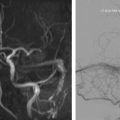Key points
- •
Tinnitus is the unwanted perception of sound in the absence of an external stimulus, and is classified by whether the sound is perceived by the patient alone, or also by the clinician (eg, subjective vs objective), and by whether it is continuous, or varies with the patient’s pulse (eg, nonpulsatile vs pulsatile).
- •
Causes of pulsatile tinnitus can broadly be divided into vascular and nonvascular types.
- •
Vascular causes of pulsatile tinnitus are numerous, and are further characterized by the location of the source of the noise within the cerebral-cervical vasculature: arterial, arteriovenous, and venous.
- •
Patients with pulsatile tinnitus should first be evaluated with contrast-enhanced CT of the head and temporal bones. When noninvasive imaging studies fail to demonstrate a cause, catheter angiography should be performed to exclude a dural arteriovenous fistula.
Introduction
Tinnitus is the unwanted perception of sound that originates, or seems to originate, from one or both ears. The word tinnitus is derived from the Latin tinnire , meaning “to ring,” although the noise may also be described as buzzing, roaring, whistling, clicking, or musical. Chronic, persistent tinnitus may affect up to 10% of adults in the general population, although only a minority of these cases are severe. Tinnitus occurs more frequently in men than women, and increases in prevalence with advancing age, being most common from 40 to 70 years. However, tinnitus has also been reported in children. The perceived severity of tinnitus may have little correlation with its impact on the patient’s life, which may range from negligible to disabling.
Tinnitus may be classified by whether the sound is perceived by the patient alone, or also by the clinician (eg, subjective vs objective), and by whether it is continuous, or varies with the patient’s pulse (eg, nonpulsatile vs pulsatile). Most cases of tinnitus are subjective and nonpulsatile, with the auditory stimulus being present without an external stimulus. In these instances, tinnitus is often associated with some degree of hearing loss and is thought to likely arise from damage to the outer hair cells of the inner ear. Imaging typically is unremarkable in these cases. Treatment options for this type of tinnitus primarily consist of patient reassurance, masking devices, and cognitive therapy. However, nonpulsatile tinnitus can rarely be associated with a treatable condition, such as a tumor compressing the eighth cranial nerve or other central nervous system processes, including stroke or demyelinating disease.
In contradistinction, pulsatile tinnitus, where the perceived sound is synchronous with the patient’s pulse, is relatively uncommon, accounting for less than 10% of tinnitus cases. Pulsatile tinnitus is often secondary to an identifiable, acquired vascular anomaly or congenital vascular variant, which produces a physical sound that is perceived by the inner ear, and may sometimes be auscultated by the clinician. Because the source of the sound is often unilateral, pulsatile tinnitus also typically localizes to one side. However, cases of bilateral pulsatile tinnitus do occur, but are more likely to be nonvascular in origin, and are typically associated with sensorineural hearing loss. Imaging plays an important role in the management of pulsatile tinnitus by helping to evaluate for potential causes, which can then facilitate treatment.
Stay updated, free articles. Join our Telegram channel

Full access? Get Clinical Tree





